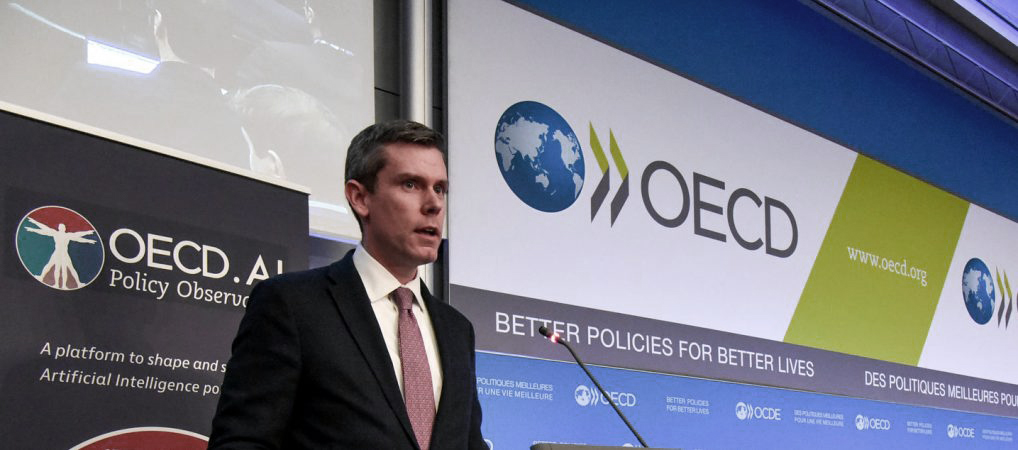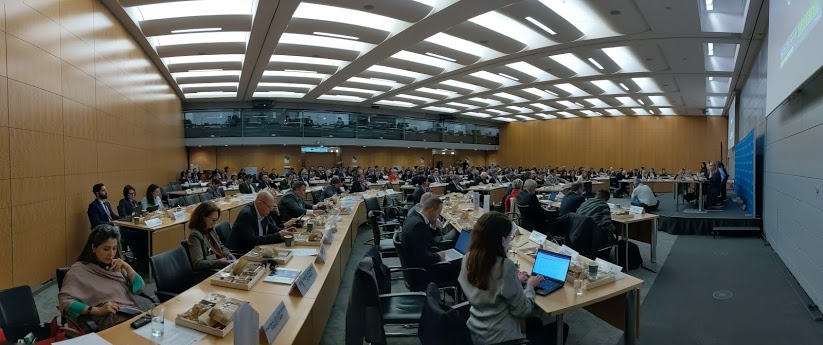The OECD Network of Experts on AI: Moving from principle to practice for trustworthy AI
The United States is proud to be the first chair of the OECD Network of Experts on AI (ONE AI), an incredible group of multi-stakeholder and multidisciplinary experts working toward the responsible development and deployment of AI.
The United States’ Adam Murray is the first Chair of OECD’s ONE AI Network of AI Experts.

The adoption of the OECD Recommendation on AI in May 2019 was a watershed moment. It was the first time governments came together around a common set of principles for the responsible stewardship of trustworthy AI. But in a sense, that was the easy part. Now, the OECD is moving “from principle to practice” by developing implementation guidance to help all AI actors responsibly design, develop, and deploy AI. Building off the successful model of the AI Group of Experts that helped develop the Recommendation, the OECD has convened a group of multi-stakeholder and multidisciplinary experts to aid in this task – the aptly named ONE AI.
ONE AI provides AI-specific expertise and facilitates information exchange
ONE AI is an informal advisory group tasked with providing the OECD with advice on policy, technical and business topics related to AI. The network is a diverse group of experts that includes representatives from government, civil society, the private sector, trade unions, the technical community, and academia. They report to the OECD Committee on Digital Economy Policy, the official group of representatives from OECD countries that who develops the Organization’s recommendations on digital economy policy, including artificial intelligence but also privacy, digital security, and much more.
The network also contributes to the OECD Policy Observatory on AI (OECD.AI) and facilitates information exchange and collaboration between the OECD and other international initiatives and organizations focusing on AI. It helps raise awareness about research and policy initiatives and identify synergies and avenues for cooperation at the OECD and beyond.
Adam Murray talks about International AI standards:
How ONE AI will work
Every year, the OECD will invite experts to join ONE AI for that year. For 2020, ONE AI has over 70 members. The OECD ensures that ONE AI is balanced in terms of multidisciplinary expertise, stakeholder representation, gender and regional representation. Experts are nominated by the OECD’s 37 member countries, the European Commission and by the four OECD stakeholder groups: Business at OECD (BIAC); the Trade Union Advisory Committee (TUAC); the OECD Civil Society Information Society Advisory Council (CSISAC); and the Internet Technical Advisory Committee (ITAC).
ONE AI also has representatives from international governmental organizations, namely UNESCO, the Council of Europe, the World Bank and the Inter-American Development Bank.
To facilitate close coordination with the OECD, the chair of ONE AI is a government official from the OECD’s Committee on Digital Economy Policy. I consider it a great privilege to be the first Chair of ONE AI and to lead such an outstanding group of experts.

ONE AI’s focus in 2020
The OECD Committee on Digital Economy Policy gave ONE AI an ambitious agenda for 2020 – design implementation guidance for the Recommendation on AI to help move from principle to practice. The network met for the first time in February 2020 at the launch of the OECD Policy Observatory on AI, and formed working groups to address three priority issues:
Working Group 1 – Classification framework for AI systems:
This working group’s mission is to devise a simplified, user-friendly classification framework for AI systems and an AI knowledge graph for AI approaches.
Working group 1 is also looking at new indicators to measure the adoption of trustworthy AI. Both of these work streams can help policy makers and will become part of the “Trends & Data” pillar on the OECD Policy Observatory on AI.
Co-moderators:
- Marko Grobelnik, AI Researcher & Digital Champion, AI Lab, Slovenia Jozef Stefan Institute
- Dewey Murdick, Director of Data Science, Center for Security and Emerging Technology (CSET), School of Foreign Service, Georgetown University
- Jack Clark, Policy Director, OpenAI
Working Group 2 – Guidance for implementing values-based AI principles:
Working group 2 has fifty eight members. It identifies Working group 2 will identify examples of implementation and good practices for the five values-based OECD AI principles, 1) inclusive growth, sustainable development and well-being; 2) human-centred values and fairness; 3) transparency and explainability; 4) robustness, security and safety; and accountability.
The group aims to help AI actors identify context-specific tools, processes, and good practices that they will allow them to concretely put principle to practice.
Co-moderators:
- Adam Murray, ONE AI Chair and U.S. delegate to CDEP
- Carolyn Nguyen, Director of Technology Policy, Microsoft
- Barry O’Brien, Government and Regulatory Affairs Executive, IBM
Working group 3 – Guidance for implementing national policies:
Working group 3 is focused on identifying and developing good practices for implementing the OECD AI Principles’ five recommendations to policy-makers: investing in AI R&D, fostering a digital ecosystem for AI, shaping an enabling policy environment for AI, building human capacity and preparing for labour market transformation, and international co-operation for trustworthy AI.
Co-moderators:
- Andras Hlács, Counsellor, Permanent Delegation of Hungary to OECD
- Michael Sellitto, Deputy Director, Stanford Institute for Human-Centered AI (HAI)
For a complete list of participants in ONE AI and further information on how to contribute to our work, please visit the AI Policy Observatory’s page dedicated to the Expert Network on OECD.ai.

































